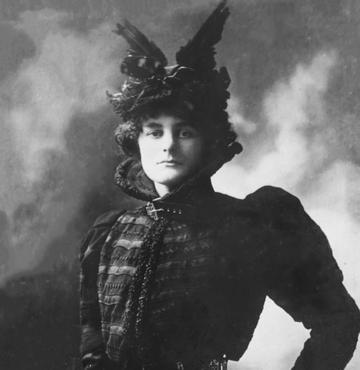Revolutionary Women
It has often been said that Ireland's is the best documented of all modern revolutions. The revolutionary generation of 1912-22 displayed a remarkable aptitude for creative writing, journalism, autobiography, correspondence and propaganda work. Despite the fact that many of them worked in clandestine and sometimes illegal operations, a good deal of this survives. The Irish women whose lives I researched were no exception. In common with Irish men, they were swept up in a tide of political activism which ranged from learning and teaching the Irish language to participating in armed revolt. A large number of them had cut their political teeth in the theatre, in journalism and in feminist politics, and they too had generated a great deal of published and private materials which chronicled their experiences.
This provided me with a great foundation for my research on nationalist women in early-twentieth-century Ireland. I was delighted but also surprised by the sheer volume of information which survived, not least because a dearth of archival material is often given as the reason for the near absence of women in many studies of the period. I quickly came to realise that the existence and survival of this material reflected the determination of Irish women to record and document their own political experiences. It also rapidly became very clear to me that the many thousands of Irish women who became active in nationalist circles in the early twentieth century did not expect to be forgotten. They chronicled their own experiences as they lived them and they displayed a sensitivity for and an appreciation of the longer history of women's political activism in Ireland. They were acutely aware of how they might be remembered by future generations and were convinced that their experiences were worth remembering in and of themselves and in the context of the wider national narrative.
This determination to be remembered can be clearly seen in their periodic attempts to establish political newspapers for women and an insistence on, at the very least, a women's column or page in the leading republican and cultural nationalist newspapers of their day. The pioneers of modern women's republicanism, Inghinidhe na hEireann (Daughters of Ireland) led the way by establishing Bean na hEireann in 1908. This was Ireland's first political newspaper written explicitly for and mainly by women. It reflected the fusion of a number of strains of radical politics at the turn of the century, most importantly feminism and Irish republicanism: Bean na hEireann was founded both to serve as an unambiguously republican journal and, as its editor pointed out in 1909, to raise the 'present position of women in the social and political life of the country'.

Maude Gonne McBride founder of Inghinidhe na hÉireann
Although this radical publication survived only until 1911, its militant editorial line and dedication to publishing original literature of various kinds attracted a varied and very prestigious collection of contributors. Many of these authors, both male and female, were the leading lights in Ireland's cultural revival movement and the newspaper itself contributed to this revival with its emphasis on Irish culture, history and language. It was not the only publication to do this, but it stood out because of its explicit interest in constructing a kind of female nationalist genealogy. In doing this, it set a precedent for subsequent women's societies, especially similarly militant ones which would also look to Ireland's past in order to justify contemporary claims of equality.
I found the attempts of the Inghinidhe's amateur historians to fill in the gaps as far as Irish women were concerned intriguing. They suggested a kind of feminist consciousness which was based on very modern ideas about women's political emancipation as well as on ideas about an imagined and enlightened Irish past in which women's ideas and rights had been upheld and taken seriously. Situating Irish women in what the Inghinidhe considered to be their rightful place in Irish history became one of the most important ways in which the organisation attempted to redefine women's roles in modern Ireland. An interest in Irish history had been a feature of the organisation from its earliest days: papers on notable Irish women were frequently read and discussed at Inghinidhe meetings, the names of Irish heroines adopted by members and the role of Irish women in nationalist history especially emphasised. But combining such ideas with modern feminist thought was not straight forward. Most members were deeply committed to women's suffrage, for example, but they also held that agitation for votes for women in Ireland implied claiming British citizenship and was thus inconsistent with separatism and republicanism. Having argued strongly that the vote for women must be won in Ireland and that the feminist cause in Ireland was best 'served by ignoring England', Bean na hEireann nonetheless maintained a strong feminist line, often by reporting on absurd and flagrant examples of sexism in Irish society. One of its writers, for instance, decided to get electricity connected to her house after a Dublin Gas Company refused to accept the name of a woman as a guarantee. 'They seem', argued the editor, 'to drag the question of sex even into gas meters'.
Reconciling feminism and nationalism would be a task faced by every major women's nationalist group in early twentieth-century Ireland. Debates between activists who prioritised women's enfranchisement and Irish nationalism differently were rehearsed in Bean na hEireann and would recur over the years, especially during times of acute political tension. This is not surprising when one considers that disagreements between nationalists and unionists, militants and non-militants, supporters of the British war effort and pacifists, were as much a feature of the broader Irish women's movement as those between Home Rulers and Republicans. But it is important not to over-emphasise discord within the Irish women's movement as has been the tendency in recent historiography. My research uncovered a remarkable level of cooperation between Irish women despite the enormous potential for conflict in which they organised. This cooperation was, I think, a more significant aspect of nationalist women's organisation than dissent, and it more fairly characterises the Irish women's movement as a whole in this period.
Why is this important? First and foremost, this matters because a historiographical emphasis on discord has meant that other, more significant aspects of women's organisation have been overlooked. It has also led to an unhelpful demarcation of Irish women's history and the political history of modern Ireland and this has obscured our understanding of both. Ireland was highly unusual in this period in that nationalism and feminism reached their zeniths at roughly the same time, producing a highly fertile but also volatile political climate for male and female activists. Neither movement developed in a political vacuum: my research emphasised the ways in which nationalism and feminism interacted and, most importantly, the ways in which each shaped the other. This was abundantly clear to the women at the heart of my study, who often used the languages of national and women's liberation interchangeably and inevitably made many connections between the two creeds as they moved between them. As Deborah Webb, a leading nationalist and feminist explained in 1912, the 'two analogous movements, like all those making for human freedom, ought, of course, to advance together'.
What is less well understood but equally important is how such influences went the other way too, and how Irish feminists and Irish feminism shaped Irish nationalism as much as they were shaped by it. Given that male republicans employed a number of suffragette strategies including militancy, political imprisonment, hunger striking and mass demonstration, this should not be surprising. Some leading republicans openly admired militant feminists, many worked with them easily and regularly and others still urged men to follow the women's example - especially when women appeared to be acting more radically than men. The republican, feminist and socialist, Helena Molony recognised this when she led a violent and illegal nationalist protest against a 1911 Royal Visit to Dublin while condemning the `contemptible' decision of the (all male) Irish Republican Brotherhood to avoid such confrontation. In a scathing critique of the way that Irish nationalist women were misrepresented in historical accounts of the revolutionary period she raged in 1934 that Irish men seemed unable to believe that any woman could `embrace an ideal — accept it intellectually, feel it as a profound emotion, and then calmly decide to make a vocation of working for its realisation'. Instead, she argued, historians attempted to `prove that every serious thing a woman does (outside nursing babies or washing pots) is the result of being in love with some man, or disappointment in love of some man, or looking for excitement, or limelight, or indulging their vanity.'
Molony was far from being alone among activist Irish women in this assessment. Like others of her generation, she was subsequently as surprised by what her friend described as women's `very meagre place in the pages of history', as she was disappointed by it. In the heat of the revolution, they imagined a different, more progressive future and they had good reason to feel optimistic about this. Independent Ireland's foundation document no less guaranteed their equality. Issued by republican leaders in fittingly dramatic surroundings on Easter Monday, 1916, the proclamation of Independence was addressed to 'Irishmen and Irishwomen' and guaranteed `religious and civil liberty, equal rights and equal opportunities to all its citizens'. In other words, it explicitly conceded the feminist case, a fact immediately recognised by the Irish suffragists who praised its `high idealism' and celebrated the progressive nature of Irish republicanism. This was followed by a number of political concessions, increased female involvement in high and popular politics and an explicit acknowledgement of the profound impact of the female vote on the seismic shift in Irish politics seen in the results of the general election of 1918.
A determination to establish political and social stability is a common feature of post-war and post-revolutionary societies, and independent Ireland proved to be no exception. Promises of equal citizenship faded quickly after 1918 and were in fact reversed in some ways. A generation of by this time seasoned political campaigners attempted to adjust to a more conservative political climate in which women's rights attracted little interest and still less support. Many of the women I followed in the 1900-1918 period became active in social questions from the 1920s, reflecting both the inability (or unwillingness) of Ireland's main political parties to engage with women and their chosen issues, and a return to prerevolutionary women's politics which had been dedicated to social as well as political reform. It also reflected the fact that Irish political life had become less rather than more open to women since 1918. It was this, as well as the growing realisation that neither enfranchisement nor independence had in fact conferred political or social equality with men on women that drove women's political activity in the early years of independence and helped to shape the tenor of modem Ireland.
Fortunately for Irish historians, many of the women who had dedicated themselves to feminism and nationalism in the early years of the twentieth century were determined to tell their stories, or at least to enable others to do so. Their publications and their recollections reflect their determination to resist historical marginalisation, and allow us to restore them to their rightful place at the heart of the historical narrative of modern Ireland.
SENIA PASETA
St Hugh's College



